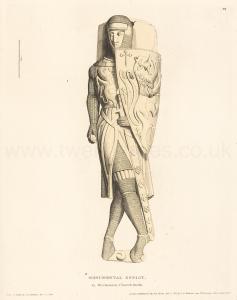Effigy of Richard Wellesburne de Montfort
Effigy of Richard Wellesburne de Montfort is in Monumental Effigies of Great Britain.
THIS very remarkable effigy lies on the north wall of the church of Hitchendon in Buckinghamshire. After the battle of Evesham in 1265, in which the famous Baron Simon de Montfort, with his eldest son Henry, lost their lives, his wifea and children fled the country, with the exception of the youngest son Richard, who assumed the name of Wellesburne (from a manor so termed in Warwickshire, an ancient possession of the family), and retired to Hinchendon as above, where he resided at a mansion called Wreck Hall. The armorial bearings on this effigy, and the peculiarities which mark the period of its execution, enable us very confidently to appropriate it to this identical personage. He became the founder of the family of Wellesburne, which was extant in the county of Buckingham, in the reign of Henry VI. In the church of Hitchendon down to that period were placed numerous monuments of his successors, one of which will be found in another place. A deed of this Wellesburne de Montfort has been printed in Nichols's History of Leicestershire, the faulty Latin of which is perhaps no proof of its being fictitious. There are two seals appended to this instrument, one of which has the legend "Sigillum Bellatoris, filii Simonis de Montefort; [Seal of the Warrior, son of Simon de Montefort]" the other bears the rampant lion of his house, the legend "Wellisburne de la Monteforte."

There is some reason to conjecture that Richard Wellesburn de Montfort was imbued with the martial character of his race. His effigy represents him in the attitude of a Crusader (he might, not improbably, have passed some of the years immediately after his father's overthrow, abroad, in the service of the cross); his right hand grasps a dagger, his left sustains a ponderous broad-bladed sword, on the scabbard of which are escutcheons of various armorial coats, borne doubtless by the connections of his noble family. On this and all the effigies of his descendants the pride of heraldry obtains, which shows that they resigned not, under adverse fortune and a change of name, the remembrance of their honours.
The quilted gambeson appears in bold folds under the hauberk and descends to the upper part of the knee. His feet rest on a lion, on which is a crescent for difference. The bearing of the shield is very remarkable; a lion rampant à la queue fourchée, holding in his mouth a childb the field semée with crosslets fitchée. The bearing is repeated on the surcoat quarterly, with a griffin segreant, holding in his paws a child, and with the addition of a chief cheque, no doubt for Mellent, to which Earldom the Montforts succeeded about the time of the Norman Conquest.
This effigy is executed in a truly noble style, and recalls to us at a glance the age of chivalry and romantic feeling; and it is somewhat remarkable, that it commemorates a name which has become hacknied among the writers of fiction, without allusion to the historic tacts connected with it, merely for its sound. The slender but striking circumstances which are known concerning Wellesburne de Montfort surely afford admirable ground-work for the writer of historical romance.
Note a. Eleanor, second daughter of King John and Isabella of Angoulesme, she retired to a nunnery at Montargis, in France. Simon her second son, was Count of Bigorre in France, where he founded a family bearing his patrimonial name; Almaric, her third son, was first a priest in York, but embraced the military profession abroad; Guy, the fourth son, was Count of Anglezia in Italy, progenitor of the Montforts of Tuscany, and of the Counts of Campobachi in Naples; Richard, the fifth son, is commemorated by the effigy.
Note b. Gules, a Hon rampant with two tails argent, was a bearing of Simon de Montfort, Earl of Leicester. See the vignette above, from an architectural decoration in Westminster Abbey. This shield with the addition of a child in the lion's mouth, was blazoned in the windows of Wreck Hall at Hitchendon, and carved on the reading desk of Hitchendon Church. Argent, a lion rampant, with ten cross-crosslets fitchée sable, are the Montforts of Warwickshire. Bendy of six. Or and Gules, changed temp. Edward 1. to bendy of ten, are the Montforts of Beldesert. Gules, a griffin segreant, a chief cheque Or and Azure, over all a bend Ermine, is a coat of the Wellesburn Montforts. There is at Hitchendon a monumental figure of a withered corpse, enshrouded in a loose shirt, having marked on his breast the figure of a priest and eight crosslets on his body. This represents, it may be well conjectured, some incumbent of the parish church of the Montfort family. Langley conceives (but the style of the figure by no means supports the idea) that it is a memorial for Peter, son of Peter de Montfort, who died at the battle of Evesham. See Hist, of Desborough Hundred, p. 478.
